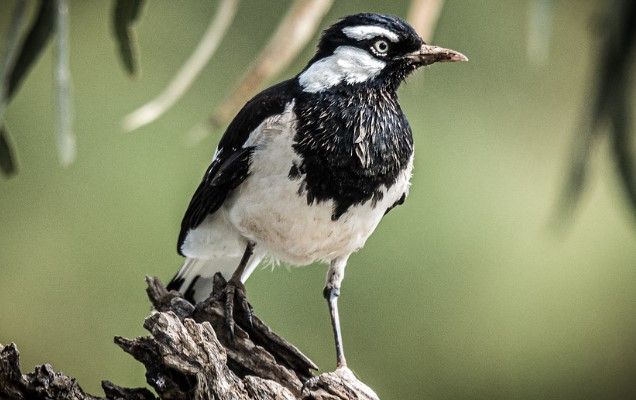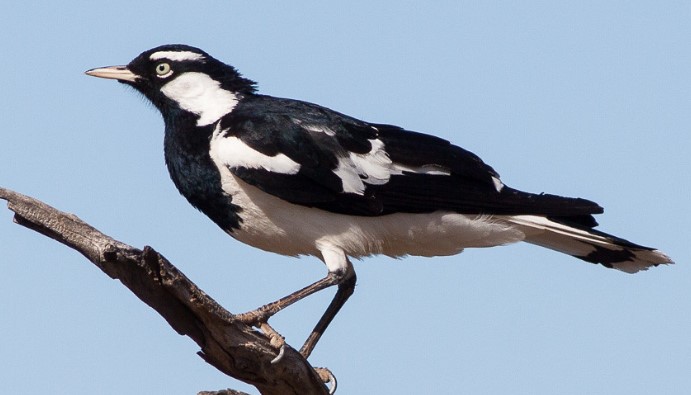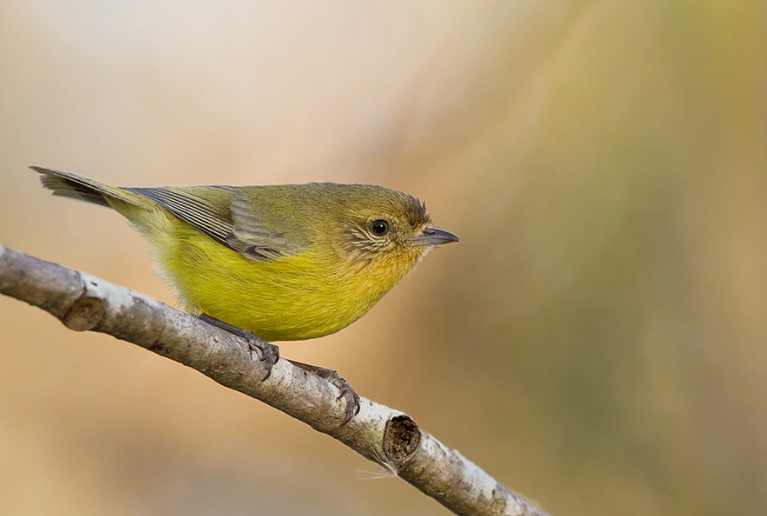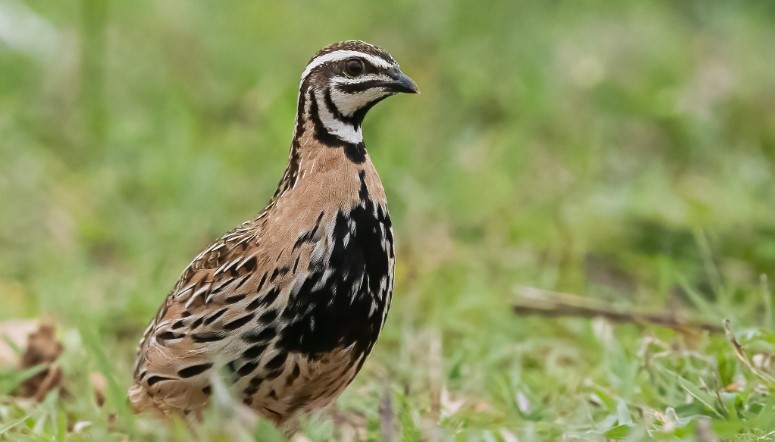Behavior and Habitats
In Australia, the Magpie-lark-or Peewee (Grallina cyanoleuca) can be found anywhere. The species thrives in Tasmania wherever there are pastures, mud, trees, and surface water available for feeding, roosting, and nesting. They usually forage in pairs or nomadic groups, picking up insects and their larvae from the ground and mollusks from shallow water. Less commonly, they pick up earthworms and earthworm larvae.
Feeding involves bobbling the head back and forth with the feet while walking. Birds make sedate progress, although if pushed, they will run; if stopped or agitated, they will wave their rump and tail. With rounded, evenly flapping wings, it flies buoyantly, slowly, and directly. During aerial skirmishes, males defend territories of about eight to ten hectares by fluttering about, lifting, and avoiding.
Identification
Male: With a black top and white band through the shoulder of the wing to the base of the inner flight feathers; the rump, base, and tip of the tail are white. Black face and throat, white eyebrows, and a small bar below the eye; white patch joining lower breast and undertail on sides of the neck. The eyes are cream in color. The bill is off-white in color, whereas the tip is black. Black is the color of the feet. The female forehead and throat are white, encircled by a black band, but she does not have a white eyebrow. Immatures: Across the forehead is a black band encircling a broad white eyebrow. There is a black band encircling the throat. The eye is dirty brown; the bill is dark grey in color.
Read More – Facts of Black-billed Magpie

Call & Song
There are a variety of loud piping calls, peewee peewees, and high dood-it dood-it made by Magpie-larks throughout their range. An alarm call is being considered by a strident pee-pee-pee. There is some scolding chatter from young birds.
Magpie-larks sing liquid, lower-pitched versions of piping calls sung by mated birds in flight, cloo-it, cloo-it. Magpie-larks are among the 200 or so species of birds that sing in duets around the world. In this case, the two birds produce about one note per second, but they are a half-second apart, so humans cannot differentiate between them.
Courtship
Courtship and territorial display become intertwined during breeding. The male and female birds call rapidly in antiphonal duets, raising their wings above their heads and fanning their tails. They fly about, calling liquidly and flapping with arresting pulsing wingbeats, before returning to a perch and displaying. Standing half a meter apart, they alternately call and posture. The head is dropped, the bill points downward, and the tail is fanned and flipped up. Bowing is accompanied by flicks of tails that are partially fanned.
Nest & Breeds
The nesting and breeding season occurs mainly from August to December but can occur at any time. The nest is constructed by both members carrying mud and materials. During the day, both birds alternate incubation shifts lasting 15–30 minutes up to an hour. In a nest, plant fiber is bound with mud and lined with grass, fur, and feathers; it is plastered to horizontal branches or manmade structures or poles four to twenty meters above ground level. Incubation usually occurs at night, and the female may raise more than one brood in a season.
In contrast to hatchling White-winged Choughs and Apostle Birds that are naked when they hatch, young magpie-larks are clothed in grey down as soon as they hatch. After they join non-breeding flocks, they maintain their distinctive pied plumage for three to four months. Non-breeding flocks do not have territorial ties and move seasonally, mainly north in autumn-winter and south in spring-summer; some reach Arnhem Land and Cape York Peninsula. As a result of breeding, flocks can grow to several thousand birds and all roost together at night.
The magpie-lark lays three to five pink-white eggs marked with red and purple-brown spots and blotches. Eggs measure about 20 x 21 mm and have an oblong-oval shape. There is a 17-18 days incubation period for both sexes. The young fledge between 19 and 23 days after hatching.
Distribution
Most parts of the Australian mainland are home to the magpie-lark. Usually found near water; avoids heavily forested areas. Also found in Timor, southern New Guinea, and on Lord Howe Island. No races.
Other Names:
The bird is also known as Australian Magpie-lark, Wee magpie, Mudlark, Murray Magpie, Peewee, and Peewit.
Size
The size of Magpie-lark is about 270–300 mm in length and the weight range is 63.9–118 grams for males and 70–94.5 grams for females.
Read More – The White-throated magpie-jay







